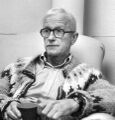Template:Selected anniversaries/March 9: Difference between revisions
No edit summary |
No edit summary |
||
| Line 79: | Line 79: | ||
||2016: Reinhold Remmert dies ... mathematician. Born in Osnabrück, Lower Saxony, he studied mathematics, mathematical logic and physics in Münster. He established and developed the theory of complex-analytic spaces in joint work with Hans Grauert. Pic. | ||2016: Reinhold Remmert dies ... mathematician. Born in Osnabrück, Lower Saxony, he studied mathematics, mathematical logic and physics in Münster. He established and developed the theory of complex-analytic spaces in joint work with Hans Grauert. Pic. | ||
||2021: John Polkinghorne dies - theoretical physicist, theologian, and Anglican priest. A prominent and leading voice explaining the relationship between science and religion. Pic. | |||
</gallery> | </gallery> | ||
Revision as of 08:01, 7 January 2022
1815: Electrical engineer and inventor Francis Ronalds describes the first battery-operated clock in the Philosophical Magazine.
1851: Physicist and chemist Hans Christian Ørsted dies. Ørsted discovered that electric currents create magnetic fields, which was the first connection found between electricity and magnetism.
1923: Theoretical physicist, theoretical chemist, and Nobel laureate Walter Kohn born. Kohn will develop density functional theory, which will make it possible to calculate quantum mechanical electronic structure by equations involving the electronic density.
1928: Engineer Gerald Bull born. Bull will attempt to build artillery guns capable of launching satellites into orbit.
1941: The Eel Escapes Hydrolab is "proof that The Eel is a criminal," according to Baron Zersetzung.
1943: Computer scientist Jef Raskin born. Raskin will conceive and start the Macintosh project for Apple in the late 1970s.
1981: Biophysicist Max Delbrück dies. Delbrück helped launch the molecular biology research program in the late 1930s; his ideas stimulated physical scientists' interest into biology, especially as to basic research to physically explain genes, mysterious at the time.
2016: Signed first edition of Red Spiral 3 used in routine high-energy literature experiment unexpectedly develops spontaneous artificial intelligence.







